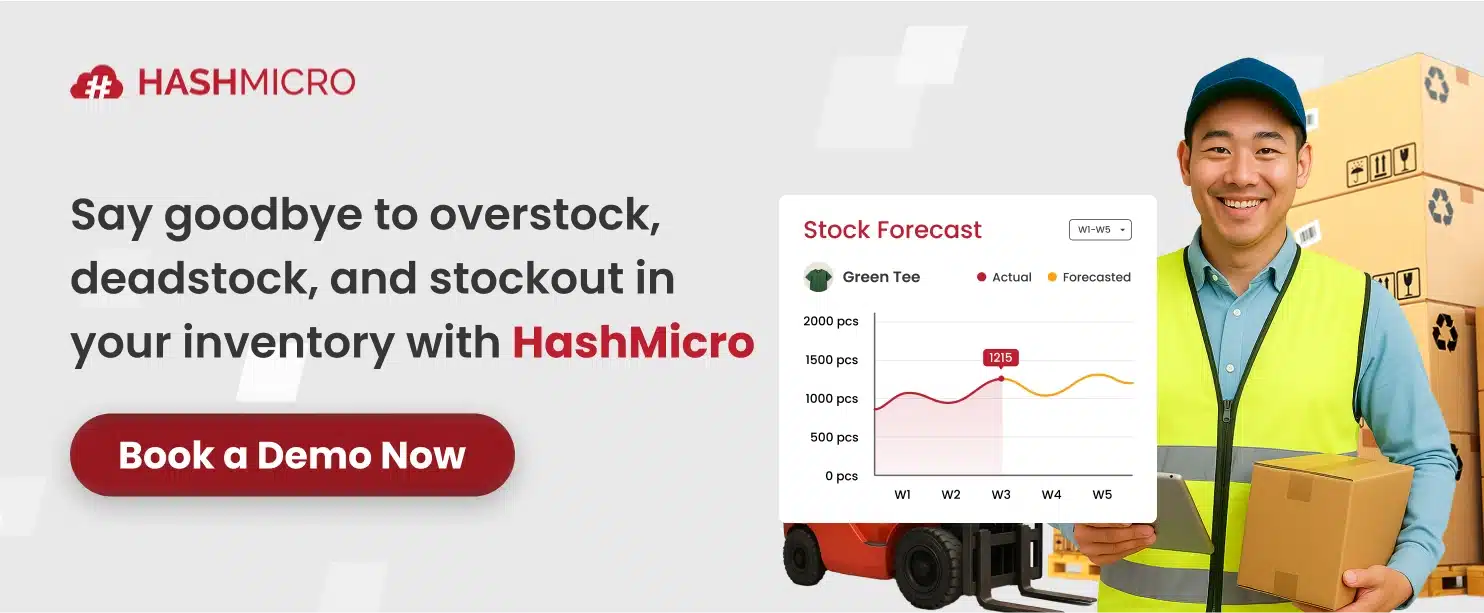As a business professional, I’ve seen how inventory management is essential for smooth operations. It involves controlling the ordering, storage, and usage of inventory to meet demand efficiently without overstocking.
Companies using optimized inventory systems often achieve up to a 30% improvement in order fulfillment, minimizing delays and boosting customer satisfaction. With the right tools, I can balance supply and demand while reducing costly stock issues.
This article covers the definition, importance, benefits, and key features of effective inventory management. Ready to optimize your operations? Get a free demo of HashMicro’s Inventory Management System and see how automation transforms your stock management.
Key Takeaways
|
What is Inventory Management?
I view inventory management as the process of monitoring and regulating stock levels, orders, sales, and deliveries to maintain optimal efficiency. Through this approach, I can balance supply and demand, reduce costs, prevent stockouts, and enhance customer satisfaction.
What are the 4 Main Types of Inventory?
I find it essential to understand the different types of inventory that I need to manage in my business. Each type plays a crucial role in ensuring a smooth and efficient supply chain. Here are the four main types of inventory:
- Raw materials: These are the basic materials that a company uses to produce goods. Managing raw materials efficiently ensures that production processes run smoothly without interruptions due to material shortages.
- Work-In-Progress (WIP): These items are in production but have not yet been completed. Effective management of WIP inventory helps track production progress and minimize delays.
- Finished goods: Products that are completed and ready for sale. Proper management of finished goods is crucial for promptly meeting customer demand and maintaining high levels of customer satisfaction.
- Maintenance, Repair, and Operations (MRO): This includes supplies used in the production process but is not part of the final product, such as maintenance supplies, spare parts, and tools.
Why Is Inventory Management Important?
An efficient stock control process helps me maintain balanced inventory levels, avoiding both overstocking and shortages. This approach allows me to cut unnecessary costs and boost overall operational efficiency.
With proper stock control, I can streamline order processing, minimize waste, and ensure raw materials and finished goods are always available on time. It also helps me keep customers satisfied by preventing delays and stockouts.
Accurate inventory data enables me to make better financial plans, forecast demand effectively, and make smarter strategic decisions. By using automated tracking and real-time insights, I can improve accuracy and stay competitive in the market.
What are the Benefits of Inventory Management?
By understanding and implementing this system, I’ve experienced numerous advantages that greatly enhance my business operations. Here’s my explanation of why inventory management is so important:
- Streamlined processes reduce the time and effort required to manage stock levels, orders, and deliveries.
- Avoid overstocking and understocking, reducing storage costs and minimizing waste.
- A structured stock control system supports compliance with legal and industry regulations.
- Improved customer satisfaction and loyalty by ensuring that products are available.
- Accurate inventory data provides insights that can inform better business decisions.
- Provides a detailed inventory movement report to monitor stock movements.
- PPIC meaning production planning and inventory control aligns stock with production to meet demand.
Inventory Management Challenges

I often face stock control challenges that can affect my business growth and profitability. Effectively addressing these issues while understanding the role of a well-structured system is essential for overcoming them. This includes managing inventory holding costs and other key challenges I commonly encounter:
- Achieving accurate inventory counts
- Balancing inventory levels
- Managing multiple sales channels
- Fluctuating customer demands and market trends
- Ensuring data accuracy and security
Inventory Management Methods
Effective stock control requires me to use different methods that suit my business needs. Each method has its own advantages and can be applied individually or combined for better inventory control. Here are some of the inventory management methods I often use:
1. ABC Analysis
ABC analysis categorizes inventory into three groups based on importance and value:
- A items are high-value products with a low frequency of sales.
- B items are moderate-value products with a moderate frequency of sales.
- C items are low-value products with a high frequency of sales.
This method helps businesses prioritize their focus and resources on managing the most critical items, ensuring that high-value products are closely monitored.
2. Just-In-Time (JIT)
The Just-In-Time method aims to minimize inventory by receiving goods only when needed for production or sales. This approach reduces carrying costs and minimizes waste but requires precise forecasting and strong supplier relationships to avoid stockouts.
3. Batch Tracking
Batch tracking involves monitoring inventory based on batches or lots. This method is particularly useful for businesses dealing with perishable goods or products with expiration dates. It helps in tracking each batch’s production, usage, and remaining shelf life, ensuring product quality and compliance with regulations.
4. Demand Forecasting
Demand forecasting uses historical data, market trends, and statistical methods to predict future inventory needs. Accurate demand forecasting helps businesses plan their inventory levels, avoid stockouts, and reduce excess inventory, ultimately improving customer satisfaction and operational efficiency.
5. Material Requirements Planning (MRP)
MRP is a system that calculates the materials needed for production and schedules their purchase. It is based on the production schedule and inventory levels, ensuring that materials are available just in time for manufacturing, reducing delays, and optimizing production processes.
6. FIFO and LIFO
- FIFO (First-In, First-Out): This method assumes that the oldest inventory items are used or sold first. It is particularly beneficial for perishable goods, as it ensures that older stock is used before it expires.
- LIFO (Last-In, First-Out): This method assumes that the most recently acquired items are used or sold first. While it can be advantageous for certain tax and accounting purposes, it may not suit businesses dealing with perishable products.
7. Economic Order Quantity (EOQ)
EOQ is a mathematical formula used to determine the optimal order quantity that minimizes the total costs of inventory, including ordering and holding costs. By calculating the ideal order size, businesses can reduce carrying costs and ensure that inventory levels are sufficient to meet demand without overstocking.
How Is Inventory Management Different from Other Processes?

I’ve noticed that stock management is often confused with other related processes. Understanding these differences is essential for me to optimize overall efficiency. Let’s explore why inventory management is important and how it differs from other processes I handle:
1. Inventory Management vs. Inventory Control
| Inventory Management | Inventory Control |
|
|
2. Inventory Management vs. Inventory Optimization
| Inventory Management | Inventory Optimization |
|
|
3. Inventory Management vs. Order Management
| Inventory Management | Order Management |
|
|
4. Inventory Management vs. Warehouse Management
| Inventory Management | Warehouse Management |
|
|
5. Inventory Management vs. Logistics
| Inventory Management | Logistics |
|
|
6. Inventory Management vs. ERP
| Inventory Management | ERP |
|
|
Maximize Efficiency & Accuracy with HashMicro’s Inventory Solution

Effective inventory management is crucial for my business’s operational success. With HashMicro’s Inventory Management Software, I can streamline processes, automate tracking, and gain real-time visibility, ensuring precise stock control and optimal resource management.
To make informed decisions, I took advantage of HashMicro’s free product tour and consultation, which helped me explore the system’s full capabilities. Trusted by leading enterprises like McDonald’s, Forbes, and Brinks, HashMicro has proven to be a reliable solution tailored to diverse industry needs.
Moreover, I can benefit from up to 70% funding support through the CTC Grant, making it easier to implement a system that perfectly aligns with my operational requirements.
Features:
- Stock Forecasting – Leverage historical data to accurately predict demand and optimize inventory levels.
- RFID Automation – Enhance stock tracking precision with automated in/out recording.
- Inventory Performance Analysis – Identify fast- and slow-moving items to refine purchasing strategies.
- Barcode & QR Code Integration – Improve inventory accuracy with seamless scanning technology. The system integrates with barcode and QR code technology, streamlining inventory tracking and management.
- Multi-Location Inventory Management – Monitor and manage stock across different locations with ease.
- Comprehensive Real-Time Reporting – Access detailed inventory insights for data-driven decision-making. Additionally, the inventory aging report provides insights into the age of your stock, helping you identify slow-moving items and prioritize the sale of older inventory before it becomes obsolete.
“Inventory management is more than tracking stock; it drives cash flow, efficiency, and customer satisfaction. With automation, businesses gain visibility and make smarter, data-driven decisions.”
— Angela Tan, Regional Manager
Ready to see how HashMicro can fit into your budget? Click the banner below to explore our pricing schemes and discover the best plan for your business needs.
Conclusion
Maintaining control over inventory is crucial for optimizing the supply chain, reducing costs, and ensuring timely delivery. Implementing a cloud based system enhances control by providing real-time stock visibility, preventing stockouts, overstock, and lost sales.
HashMicro’s Inventory Management Software provides me with a comprehensive solution through real-time tracking, automated reordering, and detailed analytics. With this system, I can maintain optimal inventory levels, prevent stock discrepancies, and streamline my daily operations.
I’ve experienced firsthand how efficient inventory control can transform my business. That’s why I signed up for a free demo to explore how HashMicro’s software can optimize my inventory processes and drive sustainable growth.

Frequently Asked Questions
-
What makes a good inventory manager?
Accurate data recording. Inventory managers must accurately record all stock details, including quantities, quality, style, type, and other relevant information. This ensures precise inventory tracking.
-
How can we manage inventory?
How to manage inventory:
1. Implement inventory management software
2. Regular audits and stock counts
3. Set reorder points
4. Use FIFO method
5. Categorize inventory
6. Forecast demand
7. Optimize storage
8. Supplier management -
What is the goal of inventory management?
The goal of inventory management is to maintain optimal stock levels to meet customer demand without overstocking or understocking. This ensures efficient operations, minimizes costs and maximizes profitability.














